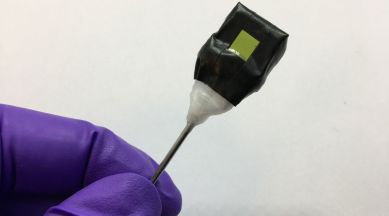Fuel from sunshine: Cambridge scientists make liquid fuels from solar power
Cambridge researchers develop ‘artificial leaf’ that converts sunlight into propanol and ethanol, replicating photosynthesis to produce a clean fuel.

Researchers from the University of Cambridge have developed an “artificial leaf” that can convert carbon dioxide into liquid fuels by harnessing the power of sunlight. Importantly, these can directly be used by internal combustion vehicles as drop-in fuels.
In essence, the researchers replicated the process of photosynthesis by converting carbon dioxide, water and sunlight into two multicarbon fuels—ethanol and propanol. This single-step process using artificial photosynthesis was described in a research article published in the journal Nature Energy last week.
“This is the first proof-of-concept study where we are showing sunlight-driven multicarbon alcohol generation using a standalone artificial leaf. At this stage, we are forming alcohols in micromoles. Further optimizations of the device are required to improve its efficiency, which we are working on. After that, it can be used for large-scale production of such fuels,” Motiar Rahaman, first author of the paper, told indianexpress.com in an email interview.
Rahaman is a research associate at the Yusuf Hamied Department of Chemistry at Cambridge.
In India, most petrol-powered vehicles now run on a blended mixture of petrol and 10 per cent ethanol, with Prime Minister Narendra Modi announcing the target was achieved on World Environment Day (June 5) last year. Bioethanol is often endorsed as a cleaner alternative to petrol since it is made from plants instead of fossil fuels.
monthly limit of free stories.
with an Express account.
But according to Erwin Reisner, who led the research, ethanol and other biofuels are a controversial technology, partly because producing them takes up agricultural land that could be used to grow food instead. Reisner is a professor in the same department as Rahaman.
For many years, the Reisner group has been working on developing sustainable, zero-carbon fuels taking inspiration from photosynthesis. In the past, they have succeeded in converting carbon dioxide into syngas, which can be used for generating electricity or producing some liquid fuels like synthetic diesel.
But in order to make that technology more practical, it should be able to produce more complex chemicals directly without first making syngas and converting it. Now, the researchers’ artificial leaf can produce clean ethanol and propanol without the need for intermediary steps.
The artificial leaf that turns sunlight into fuel
The first version of the artificial leaf that makes syngas was developed in 2019. This first prototype generated fuel by combining two light-absorbing materials with a suitable catalyst. But this device was bulky because it included thick glass and moisture-protective coatings.
To “shrink” the device, the researchers took inspiration from miniaturisation technologies in the electronics industry. They used thin-film oxides and “perovskite” materials that can be coated onto flexible plastic and metal foils. They also coated the leaf with micrometre thin water-repellent carbon-based layers that protect it from moisture.
After successfully producing syngas using a technology that worked and even looked like a real leaf, the researchers then developed a copper and palladium-based catalyst. This catalyst was optimised to allow the latest version of the artificial leaf to produce more complex chemicals.
The future of the research
If you were to nitpick, one “drawback” of the technology is that both ethanol and propanol are produced together in a photoreactor. But that might not be quite a problem when the technology is scaled up. “If we want pure ethanol and propanol, a separation process will be required. However, ethanol and propanol create a stable mixture that can be used as fuel.
Speaking of scaling up, it is perhaps important to re emphasise that this proof-of-concept is still at laboratory scale. Further work is required to augment the efficiencies of the process before it can be scaled up to produce meaningful amounts of sustainable fuels.